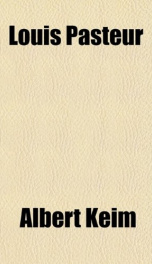louis pasteur

Purchase of this book includes free trial access to www.million-books.com where you can read more than a million books for free. This is an OCR edition with typos. Excerpt from book: CHAPTER III ON THE ROAD TO FAME IT needs only a brief examination in order to realise that the works of Pasteur, even those most widely different in appearance, follow one another like the links of a chain and present an admirable unity. Towards the end of his studies of crystals his ideas became generalised, and extended his theory of molecular dissymmetry to the constitution of the universe, while a certain laboratory experiment was destined to turn his attention to ferments. Having broken a crystal of tartrate, Pasteur plunged it again into the mother liquid, and, discovering that the crystal became restored in its entirety, he compared this breakage to a wound which is healed with the .help of new molecules of its own kind. On the other hand,he had observed that the tartrates undergo veritable fermentations, and he believed that these fermentations might be due to a microscopic organism which played the role of a ferment; so that, setting forth from crystalography, he finally arrived at researches into the origin of life. Having been appointed Professor of Chemistry and Dean of the Faculty recently founded at Lille in 1854, Pasteur, while faithfully fulfilling his pedagogical duties, prepared to carry on his studies of fermentations. He spared no pains to prove himself worthy of the confidence placed in him by M. Fortoul, the Minister of Public Instruction, and he succeeded in raising the new Faculty entrusted to him to the first rank of scientific establishments. More than two hundred auditors attended his courses, and twenty-one students were enrolled for practical work in the laboratory. He exerted himself to carry out the programme of the Minister, whose desire was to train operators and practical workers in the higher manufacturing industries, but he never ceased...
Info about the book
Author:
Series:
Unknown
ASIN:
B002ZF0ZIA
Rating:
4.5/5 (2)Your rating:
0/5
Languge:
English
Users who have this book
Users who want this book
What readers are saying
What do you think? Write your own comment on this book!
write a commentGenre
if you like louis pasteur try:
Other books by this author
Do you want to read a book that interests you? It’s EASY!
Create an account and send a request for reading to other users on the Webpage of the book!



